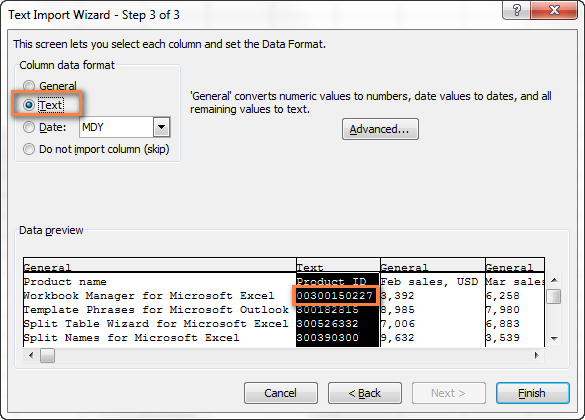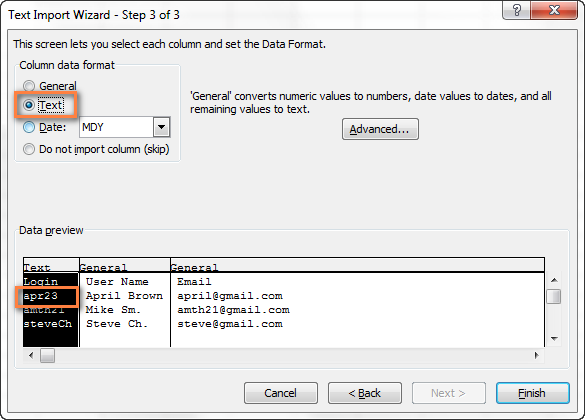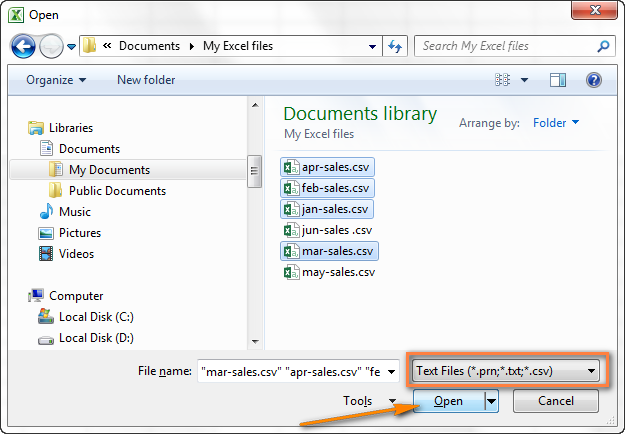Import or export text (.txt or .csv) files
There are two ways to import data from a text file with Excel: you can open it in Excel, or you can import it as an external data range. To export data from Excel to a text file, use the Save As command and change the file type from the drop-down menu.
There are two commonly used text file formats:
-
Delimited text files (.txt), in which the TAB character (ASCII character code 009) typically separates each field of text.
-
Comma separated values text files (.csv), in which the comma character (,) typically separates each field of text.
You can change the separator character that is used in both delimited and .csv text files. This may be necessary to make sure that the import or export operation works the way that you want it to.
Note: You can import or export up to 1,048,576 rows and 16,384 columns.
Import a text file by opening it in Excel
You can open a text file that you created in another program as an Excel workbook by using the Open command. Opening a text file in Excel does not change the format of the file — you can see this in the Excel title bar, where the name of the file retains the text file name extension (for example, .txt or .csv).
-
Go to File > Open and browse to the location that contains the text file.
-
Select Text Files in the file type dropdown list in the Open dialog box.
-
Locate and double-click the text file that you want to open.
-
If the file is a text file (.txt), Excel starts the Import Text Wizard. When you are done with the steps, click Finish to complete the import operation. See Text Import Wizard for more information about delimiters and advanced options.
-
If the file is a .csv file, Excel automatically opens the text file and displays the data in a new workbook.
Note: When Excel opens a .csv file, it uses the current default data format settings to interpret how to import each column of data. If you want more flexibility in converting columns to different data formats, you can use the Import Text Wizard. For example, the format of a data column in the .csv file may be MDY, but Excel’s default data format is YMD, or you want to convert a column of numbers that contains leading zeros to text so you can preserve the leading zeros. To force Excel to run the Import Text Wizard, you can change the file name extension from .csv to .txt before you open it, or you can import a text file by connecting to it (for more information, see the following section).
-
Import a text file by connecting to it (Power Query)
You can import data from a text file into an existing worksheet.
-
On the Data tab, in the Get & Transform Data group, click From Text/CSV.
-
In the Import Data dialog box, locate and double-click the text file that you want to import, and click Import.
-
In the preview dialog box, you have several options:
-
Select Load if you want to load the data directly to a new worksheet.
-
Alternatively, select Load to if you want to load the data to a table, PivotTable/PivotChart, an existing/new Excel worksheet, or simply create a connection. You also have the choice of adding your data to the Data Model.
-
Select Transform Data if you want to load the data to Power Query, and edit it before bringing it to Excel.
-
If Excel doesn’t convert a particular column of data to the format that you want, then you can convert the data after you import it. For more information, see Convert numbers stored as text to numbers and Convert dates stored as text to dates.
Export data to a text file by saving it
You can convert an Excel worksheet to a text file by using the Save As command.
-
Go to File > Save As.
-
Click Browse.
-
In the Save As dialog box, under Save as type box, choose the text file format for the worksheet; for example, click Text (Tab delimited) or CSV (Comma delimited).
Note: The different formats support different feature sets. For more information about the feature sets that are supported by the different text file formats, see File formats that are supported in Excel.
-
Browse to the location where you want to save the new text file, and then click Save.
-
A dialog box appears, reminding you that only the current worksheet will be saved to the new file. If you are certain that the current worksheet is the one that you want to save as a text file, click OK. You can save other worksheets as separate text files by repeating this procedure for each worksheet.
You may also see an alert below the ribbon that some features might be lost if you save the workbook in a CSV format.
For more information about saving files in other formats, see Save a workbook in another file format.
Import a text file by connecting to it
You can import data from a text file into an existing worksheet.
-
Click the cell where you want to put the data from the text file.
-
On the Data tab, in the Get External Data group, click From Text.
-
In the Import Data dialog box, locate and double-click the text file that you want to import, and click Import.
Follow the instructions in the Text Import Wizard. Click Help
on any page of the Text Import Wizard for more information about using the wizard. When you are done with the steps in the wizard, click Finish to complete the import operation.
-
In the Import Data dialog box, do the following:
-
Under Where do you want to put the data?, do one of the following:
-
To return the data to the location that you selected, click Existing worksheet.
-
To return the data to the upper-left corner of a new worksheet, click New worksheet.
-
-
Optionally, click Properties to set refresh, formatting, and layout options for the imported data.
-
Click OK.
Excel puts the external data range in the location that you specify.
-
If Excel does not convert a column of data to the format that you want, you can convert the data after you import it. For more information, see Convert numbers stored as text to numbers and Convert dates stored as text to dates.
Export data to a text file by saving it
You can convert an Excel worksheet to a text file by using the Save As command.
-
Go to File > Save As.
-
The Save As dialog box appears.
-
In the Save as type box, choose the text file format for the worksheet.
-
For example, click Text (Tab delimited) or CSV (Comma delimited).
-
Note: The different formats support different feature sets. For more information about the feature sets that are supported by the different text file formats, see File formats that are supported in Excel.
-
-
Browse to the location where you want to save the new text file, and then click Save.
-
A dialog box appears, reminding you that only the current worksheet will be saved to the new file. If you are certain that the current worksheet is the one that you want to save as a text file, click OK. You can save other worksheets as separate text files by repeating this procedure for each worksheet.
-
A second dialog box appears, reminding you that your worksheet may contain features that are not supported by text file formats. If you are interested only in saving the worksheet data into the new text file, click Yes. If you are unsure and would like to know more about which Excel features are not supported by text file formats, click Help for more information.
For more information about saving files in other formats, see Save a workbook in another file format.
The way you change the delimiter when importing is different depending on how you import the text.
-
If you use Get & Transform Data > From Text/CSV, after you choose the text file and click Import, choose a character to use from the list under Delimiter. You can see the effect of your new choice immediately in the data preview, so you can be sure you make the choice you want before you proceed.
-
If you use the Text Import Wizard to import a text file, you can change the delimiter that is used for the import operation in Step 2 of the Text Import Wizard. In this step, you can also change the way that consecutive delimiters, such as consecutive quotation marks, are handled.
See Text Import Wizard for more information about delimiters and advanced options.
If you want to use a semi-colon as the default list separator when you Save As .csv, but need to limit the change to Excel, consider changing the default decimal separator to a comma — this forces Excel to use a semi-colon for the list separator. Obviously, this will also change the way decimal numbers are displayed, so also consider changing the Thousands separator to limit any confusion.
-
Clear Excel Options > Advanced > Editing options > Use system separators.
-
Set Decimal separator to , (a comma).
-
Set Thousands separator to . (a period).
When you save a workbook as a .csv file, the default list separator (delimiter) is a comma. You can change this to another separator character using Windows Region settings.
Caution: Changing the Windows setting will cause a global change on your computer, affecting all applications. To only change the delimiter for Excel, see Change the default list separator for saving files as text (.csv) in Excel.
-
In Microsoft Windows 10, right-click the Start button, and then click Settings.
-
Click Time & Language, and then click Region in the left panel.
-
In the main panel, under Regional settings, click Additional date, time, and regional settings.
-
Under Region, click Change date, time, or number formats.
-
In the Region dialog, on the Format tab, click Additional settings.
-
In the Customize Format dialog, on the Numbers tab, type a character to use as the new separator in the List separator box.
-
Click OK twice.
-
In Microsoft Windows, click the Start button, and then click Control Panel.
-
Under Clock, Language, and Region, click Change date, time, or number formats.
-
In the Region dialog, on the Format tab, click Additional settings.
-
In the Customize Format dialog, on the Numbers tab, type a character to use as the new separator in the List separator box.
-
Click OK twice.
Note: After you change the list separator character for your computer, all programs use the new character as a list separator. You can change the character back to the default character by following the same procedure.
Need more help?
You can always ask an expert in the Excel Tech Community or get support in the Answers community.
See Also
Import data from external data sources (Power Query)
Need more help?
Want more options?
Explore subscription benefits, browse training courses, learn how to secure your device, and more.
Communities help you ask and answer questions, give feedback, and hear from experts with rich knowledge.
Download Article
Download Article
This wikiHow teaches you how to save a CSV document on your computer as a separate XLS (Excel Workbook format) file. Your original CSV file will not be changed, and the converted XLS will be saved as a separate file.
-
1
Open the CSV file you want to convert in Excel. Find the CSV file you want to convert on your computer, and double-click on its name or icon to open it.
- Alternatively, you can open Microsoft Excel, and open the CSV file from your recent files list.
-
2
Click the File tab. It will open a drop-down menu of your file options.
- On Windows, you can find this button in the upper-left corner of the Excel window.
- On Mac, this button is located on your menu bar in the upper-left corner of your screen.
Advertisement
-
3
Click Save As on the File menu. This option will allow you to save your CSV file in a different file format.
- You can also use a keyboard shortcut to open the Save As window.
- The Save As shortcut is Ctrl+⇧ Shift+S on Windows, and ⌘ Command+⇧ Shift+S on Mac.
-
4
Select This PC or On My Mac. This option will allow you to save your converted XLS file to your computer’s local storage.
- On Windows, you can find the This PC button below One Drive on the Save As menu.
- On Mac, click the On My Mac button in the lower-left corner of the Save As window. If you see a different button here labeled Online Locations, you can skip this step.
-
5
Select Excel 97-2003 Workbook (.xls) as your file format. Click the drop-down file format selector at the bottom of the Save As window, and select XLS as your format.
- This drop-down menu is labeled as Save as type on Windows, and File Format on Mac.
-
6
Select a saving location for your converted XLS file. Find the folder where you want to save your XLS file, and click on its name in the Save As window.
-
7
Click the Save button. You can find this button in the lower-right corner of the Save As window. It will convert your CSV file to XLS, and save a copy to the selected location.
- Your converted XLS will be saved as a separate file. The original CSV file will not be changed.
Advertisement
Ask a Question
200 characters left
Include your email address to get a message when this question is answered.
Submit
Advertisement
Thanks for submitting a tip for review!
About This Article
Article SummaryX
1. Open your CSV file in Excel.
2. Click the File menu, and select Save As.
3. Select This PC on Windows, or On My Mac on Mac.
4. Select Excel 97-2003 Workbook (.xls) as your file format.
5. Select a saving location.
6. Click Save.
Did this summary help you?
Thanks to all authors for creating a page that has been read 21,239 times.
Is this article up to date?
CSV to XLSX (EXCEL) Converter
Convert your csv files to xlsx online & free
Drop files here. 100 MB maximum file size or Sign Up
Convert to CSV
csv
Comma-Separated Values
Is a text format used for representing tabular data. Each file line is located on a separate line in the table. The values of the columns are separated by a delimiter, most often a comma. However, other symbols can be used as delimiters as well.
XLSX Converter
xlsx
Office Open XML Worksheet Sheet
XLSX is a file format created with Microsoft Excel, version from 2007 and younger. This file is a spreadsheet. All data distributed document and stored in the cells. Each cell has a unique address, which is denoted by the letters and Arabic numerals. XLSX file format is based on the Open XML. To reduce the size of the file is compressed ZIP.
How to convert CSV to XLSX
Step 1
Upload csv-file(s)
Select files from Computer, Google Drive, Dropbox, URL or by dragging it on the page.
Step 2
Choose «to xlsx»
Choose xlsx or any other format you need as a result (more than 200 formats supported)
Step 3
Download your xlsx
Let the file convert and you can download your xlsx file right afterwards
CSV to XLSX Quality Rating
4.8 (80,914 votes)
You need to convert and download at least 1 file to provide feedback!
Steps to convert content from a TXT or CSV file into Excel
- Open the Excel spreadsheet where you want to save the data and click the Data tab.
- In the Get External Data group, click From Text.
- Select the TXT or CSV file you want to convert and click Import.
- Select “Delimited”.
- Click Next.
Contents
- 1 How do I convert a CSV file to Xlsx?
- 2 How do I open a CSV file in Excel with columns?
- 3 How do I automatically open a CSV file in Excel?
- 4 How do I change a file type in Excel?
- 5 Why can’t I open a CSV file in Excel?
- 6 How do I convert a CSV file to a column?
- 7 How do I change a CSV file to delimiter in Excel?
- 8 How do I open a CSV file in Excel instead of numbers?
- 9 How do I make Excel default?
- 10 How do I change a file type?
- 11 What is an XLSX file?
- 12 How do I save a CSV file without changing the format?
- 13 How do I convert a CSV file to Excel 365?
- 14 How do I convert a CSV file to a semicolon in Excel?
- 15 How do I change data in a CSV file?
- 16 How do I change my default csv file to open in Windows?
- 17 How do I make Excel default in Windows 10?
- 18 How do I change a file type in Windows 10?
- 19 How do I open a file type in Windows 10?
- 20 How do I change the file type in Windows 10?
How do I convert a CSV file to Xlsx?
How to save CSV file in Excel
- In your Excel worksheet, click File > Save as.
- Browse for the folder where you want to save the file.
- To save as an Excel file, select Excel Workbook (*. xlsx) from the Save as type drop-down menu. To save as a comma-separated file, select CSV (Comma delimited) or CSV UTF-8.
- Click Save.
How do I open a CSV file in Excel with columns?
Using “Data – From Text” to open files
- Open a new Excel sheet.
- Click the Data tab, then From Text.
- Select the CSV file that has the data clustered into one column.
- Select Delimited, then make sure the File Origin is Unicode UTF-8.
- Select Comma (this is Affinity’s default list separator).
- Finally, click Finish.
How do I automatically open a CSV file in Excel?
Click the Microsoft Excel option under ‘Recommended Programs‘, then click the OK button. From the list of ‘Recommended Programs’, choose Excel. Any CSV file you click to open with now open in Excel automatically.
How do I change a file type in Excel?
You can change the file type that is used by default when you save a workbook.
- Click the Microsoft Office Button. , and then click Excel Options.
- In the Save category, under Save workbooks, in the Save files in this format box, click the file format that you want to use by default.
Why can’t I open a CSV file in Excel?
Trouble With Opening CSV Files With Excel? The Comma and Semicolon Issue in Excel Due to Regional Settings for Europe. When opening standard CSV (Comma Separated Values) files in Excel you may find that Excel did not recognize the fields and simply displays all data in the first column.
How do I convert a CSV file to a column?
Split CSV data into different columns
- Go to DataText > to Columns, and the wizard will walk you through the process.
- Select the cell or column that contains the text you want to split.
- Click DataText > to Columns.
- This starts the Convert Text to Columns Wizard.
How do I change a CSV file to delimiter in Excel?
Solution
- Make sure Microsoft Excel is closed before trying to change the CSV delimiter.
- Open Control Panel.
- Next, you need to access Regional Settings.
- Click the “Additional Settings” -button.
- Find the “List separator” and change it to your preferred delimiter such as a pipe (“|”).
How do I open a CSV file in Excel instead of numbers?
Opening a CSV File in Excel
- Open Excel.
- Click New, then click on Blank workbook.
- Click on the Data tab.
- Click Get External Data From Text.
- Navigate to the CSV-formatted file saved on your system, select it, then click Import (When browsing to find the file, set browser to look for All Files or for Text Files)
How do I make Excel default?
Click “Default Programs.” Wait for the app to start, then select “Set your default programs.” Find desired Excel version in the list. Select desired Excel version and select “Set this program as default.”
How do I change a file type?
You can also do it by right-clicking on the unopened file and clicking on the “Rename” option. Simply change the extension to whatever file format you want and your computer will do the conversion work for you.
What is an XLSX file?
xlsx file extension is a Microsoft Excel Open XML Spreadsheet (XLSX) file created by Microsoft Excel. You can also open this format in other spreadsheet apps, such as Apple Numbers, Google Docs, and OpenOffice. They are stored as a compressed Zip file, which contains a bunch of other files used to open the document.
How do I save a CSV file without changing the format?
Save the data in plain text files
- From the menu bar, File → Save As.
- Next to “Format:”, click the drop-down menu and select “Comma Separated Values (CSV)”
- Click “Save”
- Excel will say something like, “This workbook contains features that will not work…”. Ignore that and click “Continue”.
- Quit Excel.
How do I convert a CSV file to Excel 365?
On the Data tab, in the Get & Transform Data group, click From Text/CSV. In the Import Data dialog box, locate and double-click the text file that you want to import, and click Import. In the preview dialog box, you have several options: Select Load if you want to load the data directly to a new worksheet.
How do I convert a CSV file to a semicolon in Excel?
- save as your file with the classic way as CSV (comma delimited)
- right click on csv file and open with.. > Notepad.
- Edit > Select All and using find-replace method. find: comma [,] and…. replace with semicolon [;]
- save as the file with encoding utf-8.
How do I change data in a CSV file?
Open the CSV file in Microsoft Excel or a compatible application, such as a text editor or Notepad. Move your cursor to an empty line and type an H in column A. Press the Tab key to move to the next column and enter the value that you want to import for that field. Repeat step b for all the fields in the row.
How do I change my default csv file to open in Windows?
You can go to Control Panel and set Excel to be the default program if you wanted to open a . csv file. Press Windows key and type Default Programs. Select Default Programs and click Set your default programs.
How do I make Excel default in Windows 10?
Change default programs in Windows 10
- On the Start menu, select Settings > Apps > Default apps.
- Select which default you want to set, and then choose the app. You can also get new apps in Microsoft Store.
- You may want your .
How do I change a file type in Windows 10?
Click the View tab in File Explorer and then click the Options button (or click the drop down menu and click Change folder and search options) as shown below. To view file extensions, uncheck the Hide extensions for known file types option. Click OK when done.
How do I open a file type in Windows 10?
Open File Explorer; if you do not have an icon for this in the task bar; click Start, click Windows System, and then File Explorer. Click the View tab in File Explorer. Click the box next to File name extensions to see file extensions.
How do I change the file type in Windows 10?
Like Windows 11, Windows 10 uses Settings instead of Control Panel to make changes to file type associations.
- Right-click the Start button (or use the WIN+X hotkey) and choose Settings.
- Select Apps from the list.
- Choose Default apps on the left.
- Scroll down a little and select Choose default apps by file type.
В этой статье Вы найдёте 2 простых способа преобразовать файл CSV в Excel. Кроме того, Вы узнаете, как импортировать в Excel несколько файлов CSV и как справиться с ситуациями, когда часть данных из файла CSV не отображается корректно на листе Excel.
Недавно мы начали изучать особенности формата CSV (Comma-Separated Values – значения, разделённые запятой) и различные способы преобразования файла Excel в CSV. Сегодня мы займёмся обратным процессом – импортом CSV в Excel.
Эта статья покажет Вам, как открывать CSV в Excel и как импортировать одновременно несколько файлов CSV. Мы также обозначим возможные подводные камни и предложим наиболее эффективные решения.
- Как преобразовать CSV в Excel
- Преобразование CSV в Excel: проблемы и решения
Содержание
- Как преобразовать CSV в Excel
- Как открыть файл CSV в Excel
- Как открыть файл CSV при помощи Проводника Windows
- Как импортировать CSV в Excel
- Преобразование CSV в Excel: проблемы и решения
- Файл CSV отображается в Excel неправильно
- Первые нули теряются при открытии файла CSV в Excel
- Excel преобразует некоторые значения в даты при открытии файла CSV
- Как импортировать в Excel несколько файлов CSV
Как преобразовать CSV в Excel
Если Вам нужно вытащить какую-то информацию на лист Excel из базы данных Вашей компании, то первая же идея, что приходит на ум, – экспортировать базу данных в файл CSV, а затем импортировать файл CSV в Excel.
Существует 3 способа преобразования CSV в Excel: Вы можете открыть файл с расширением .csv непосредственно в Excel, дважды кликнуть по файлу в Проводнике Windows либо импортировать CSV в Excel, как внешний источник данных. Далее я подробно расскажу об этих трёх способах и укажу преимущества и недостатки каждого из них.
- Способ 1: Открываем файл CSV в Excel
- Способ 2: Открываем файл CSV в Excel при помощи Проводника Windows
- Способ 3: Импортируем CSV в Excel
Как открыть файл CSV в Excel
Даже если файл CSV создан в другой программе, Вы всегда можете открыть его как книгу Excel при помощи команды Open (Открыть).
Замечание: Открытие файла CSV в Excel не изменяет формат файла. Другими словами, файл CSV при этом не будет преобразован в файл Excel (формат .xls или .xlsx), он сохранит свой изначальный тип (.csv или .txt).
- Запустите Microsoft Excel, на вкладке Home (Главная) нажмите Open (Открыть).
- Появится диалоговое окно Open (Открытие документа), в выпадающем списке в нижнем правом углу выберите Text Files (Текстовые файлы).
- Найдите в Проводнике Windows файл CSV и откройте его, дважды кликнув по нему.
Если Вы открываете файл CSV, то Excel откроет его сразу же вставив данные в новую книгу Excel. Если Вы открываете текстовый файл (.txt), то Excel запустит Мастер импорта текстов. Подробнее об этом читайте в разделе Импортируем CSV в Excel.
Замечание: Когда Microsoft Excel открывает файл CSV, то для того, чтобы понять, как именно импортировать каждый столбец данных, он использует настройки форматирования, заданные по умолчанию.
Если данные соответствуют хотя бы одному из следующих пунктов, то воспользуйтесь Мастером импорта текстов:
- В файле CSV использованы различные разделители;
- В файле CSV использованы различные форматы даты;
- Вы преобразуете данные, среди которых есть числа с нулём в начале, и Вы хотите сохранить этот ноль;
- Вы хотите предварительно просмотреть, как будут импортированы данные из файла CSV в Excel;
- Вам хочется большей гибкости в работе.
Чтобы заставить Excel запустить Мастер импорта текстов, Вы можете либо изменить расширение фала с .csv на .txt (прежде чем открывать файл), либо импортировать CSV в Excel так, как это будет описано далее.
Как открыть файл CSV при помощи Проводника Windows
Это самый быстрый способ открыть CSV в Excel. В Проводнике Windows дважды кликните по файлу .csv, и он откроется как новая книга Excel.
Однако, этот способ сработает только в том случае, если приложение Microsoft Excel установлено как программа, заданная по умолчанию, для открытия файлов .csv. Если это так, то Вы будете видеть знакомую иконку в Проводнике Windows рядом с именем файла.
Если Excel не является программой по умолчанию, вот как Вы можете это исправить:
- Кликните правой кнопкой мыши по любому файлу .csv в Проводнике Windows и в открывшемся контекстном меню нажмите Open with (Открыть с помощью) > Choose default program (Выбрать программу).
- Выберите Excel в списке рекомендованных программ, убедитесь, что стоит галочка для параметра Always use the selected program to open this kind of file (Всегда использовать выбранное приложение для такого типа файлов) и нажмите ОК.
Как импортировать CSV в Excel
Этим способом Вы можете импортировать данные из файла .csv в существующий или в новый лист Excel. В отличие от предыдущих двух способов, он не просто открывает CSV в Excel, а именно конвертирует формат .csv в .xlsx (если Вы используете Excel 2007, 2010 или 2013) или .xls (в версиях Excel 2003 и более ранних).
- Откройте нужный лист Excel и кликните по ячейке, куда нужно импортировать данные из файла .csv или .txt.
- На вкладке Data (Данные) в разделе Get External Data (Получение внешних данных) кликните From Text (Из текста).
- Найдите файл .csv, который требуется импортировать, выберите его и нажмите кнопку Import (Импорт), или просто дважды кликните по нужному CSV файлу.
- Откроется Мастер импорта текстов, Вам нужно просто выполнить его шаги.
Прежде, чем мы двинемся дальше, пожалуйста, посмотрите на снимок экрана ниже, на нем показан исходный файл CSV и желаемый результат в Excel. Надеюсь, это поможет Вам лучше понять, почему мы выбираем те или иные параметры настроек в последующем примере.
- Шаг 1. Выберите формат данных и номер строки, с которой нужно начинать импорт. Чаще всего выбирают Delimited (С разделителями) и со строки 1. Область предварительного просмотра в нижней части диалогового окна мастера показывает первые несколько записей импортируемого файла CSV.
- Шаг 2. На этом шаге нужно выбрать разделители и ограничитель строк. Delimiter (Разделитель) – это символ, который разделяет значения в файле CSV. Если в Вашем файле CSV использован какой-то символ, которого нет в предложенном списке, то поставьте галочку в варианте Other (Другой) и введите нужный символ. В нашем примере мы указали Tab (Знак табуляции) и Comma (Запятая), чтобы каждый товар (они разделены табуляцией) начинался с новой строки, а информация о товаре, например, ID и данные о продажах (они разделены запятыми), были помещены в разные ячейки.Text qualifier (Ограничитель строк) – это символ, в который заключены отдельные значения. Весь текст, заключённый между такими символами, например, «текст1, текст2», будет импортирован как одно значение, даже если в этом тексте содержится символ, указанный Вами как разделитель.В этом примере мы указали запятую как разделитель, и кавычки как ограничитель строк. В результате, все числа с разделителем десятичных разрядов (которым тоже в нашем случае служит запятая!) будут импортированы в одну ячейку, как это видно в области предпросмотра на рисунке ниже. Если мы не укажем кавычки как ограничитель строк, то все числа будут импортированы в разные ячейки.
- Шаг 3. Посмотрите в область Data preview (Образец разбора данных). Если Вы довольны тем, как выглядят Ваши данные, тогда жмите кнопку Finish (Готово).
- Шаг 1. Выберите формат данных и номер строки, с которой нужно начинать импорт. Чаще всего выбирают Delimited (С разделителями) и со строки 1. Область предварительного просмотра в нижней части диалогового окна мастера показывает первые несколько записей импортируемого файла CSV.
Совет: Если в Вашем файле CSV используется последовательно более одной запятой или другого символа-разделителя, то поставьте галочку для параметра Treat consecutive delimiters as one (Считать последовательные разделители одним), чтобы избежать появления пустых ячеек.
- Выберите, куда вставлять импортированные данные, на существующий или на новый лист, и нажмите ОК, чтобы завершить импорт файла CSV в Excel.
Совет: Вы можете нажать кнопку Properties (Свойства), чтобы настроить дополнительные параметры, такие как обновление, разметка и форматирование для импортированных данных.
Замечание: Если Ваш файл CSV содержит численные данные или даты, Excel может преобразовать их с ошибками. Чтобы изменить формат импортированных данных, выберите столбец (столбцы), в которых возникли ошибки, кликните по ним правой кнопкой мыши и в контекстном меню выберите Format cells (Формат ячеек).
Преобразование CSV в Excel: проблемы и решения
Формат CSV используется уже более 30 лет, но несмотря на его длительную историю, он никогда не был официально задокументирован. Название CSV (Comma-Separated Values) возникло из-за использования запятых для разделения полей данных. Но это в теории. На самом деле, множество так называемых CSV-файлов используют другие символы для разделения данных, например:
- Табуляция – TSV-файлы (tab-separated values)
- Точка с запятой – SCSV-файлы (semicolon separated values)
Некоторые вариации файлов CSV разделяют поля данных одинарными или двойными кавычками, другие требуют маркер последовательности байтов из Юникода (BOM), например, UTF-8, для корректной интерпретации Юникода.
Это отсутствие стандартов порождает разнообразные проблемы, с которыми Вы можете столкнуться, пытаясь преобразовать файл Excel в CSV, и особенно, когда импортируете файл CSV в Excel. Давайте разберёмся с известными проблемами, начиная с самой распространённой.
- Файл CSV отображается в Excel неправильно (все данные помещены в первый столбец)
- Первые нули потеряны при открытии файла CSV в Excel
- Значения преобразованы в даты при импорте файла CSV в Excel
Файл CSV отображается в Excel неправильно
Признаки: Вы пытаетесь открыть файл CSV в Excel, и все данные попадают в первый столбец.
Причина: Корень проблемы кроется в том, что в Ваших региональных и языковых настройках Windows и в Вашем файле CSV установлены различные разделители. В Северной Америке и некоторых других странах разделителем полей списка по умолчанию является запятая. В то время как в Европейских странах запятая используется как разделитель десятичных разрядов, а разделителем полей списка является точка с запятой.
Решение: Есть несколько возможных решений этой проблемы. Вы можете быстро просмотреть приведённые ниже рекомендации и выбрать наиболее подходящие для конкретно Вашей задачи.
- Укажите правильный разделитель непосредственно в файле CSV. Откройте файл CSV в любом текстовом редакторе (подойдёт даже обычный блокнот) и в первой строке вставьте следующий текст. Обратите внимание, что это должна быть отдельная строка перед любыми другими данными:
- Чтобы установить разделитель запятую: sep=,
- Чтобы установить разделитель точку с запятой: sep=;
Как Вы уже догадались, таким образом можно установить в качестве разделителя любой другой символ, просто указав его сразу после знака равенства.
- Выберите нужный разделитель в Excel. В Excel 2013 или 2010 на вкладке Data (Данные) в разделе Data Tools (Работа с данными) нажмите Text To Columns (Текст по столбцам).
Когда запустится Мастер распределения текста по столбцам, на первом шаге выберите формат данных Delimited (С разделителями) и нажмите Next (Далее). На втором шаге выберите нужный разделитель и нажмите Finish (Готово).
- Измените расширение с .csv на .txt. Открытие файла .txt в Excel приведёт к запуску Мастера импорта текстов, и Вы сможете выбрать нужный разделитель, как это было описано в разделе Как импортировать CSV в Excel.
- Откройте файл CSV с точкой с запятой в качестве разделителя при помощи VBA. Вот пример кода VBA, который открывает в Excel файл CSV, где в качестве разделителя используется точка с запятой. Код был написан несколько лет назад для более ранних версий Excel (2000 и 2003), но если Вы достаточно хорошо знакомы с VBA, то у Вас не должно возникнуть проблем с его обновлением или изменением для работы с файлами CSV с запятой в качестве разделителя.
Замечание: Все показанные решения изменяют разделитель только для данного файла CSV. Если Вы хотите раз и навсегда изменить разделитель, заданный по умолчанию, то Вам подойдёт следующее решение.
- Изменяем разделители в настройках региональных стандартов. Нажмите кнопку Start (Пуск) и запустите Control Panel (Панель управления), кликните пункт Region and Language (Региональные стандарты) > Additional Settings (Дополнительные параметры). Откроется диалоговое окно Customize Format (Настройка формата), в котором Вам нужно выбрать точку (.) для параметра Decimal symbol (Разделитель целой и дробной части), и установить запятую (,) для параметра List separator (Разделитель элементов списка).
Примечание переводчика: Данные настройки приведены для английской локализации Excel (и ряда других стран). Для русской локализации привычнее будет использовать запятую в качестве разделителя целой и дробной части и точку с запятой для разделения элементов списка.
Дважды нажмите ОК, чтобы закрыть диалоговые окна – всё готово! С этого момента Microsoft Excel будет открывать и отображать все файлы CSV (с разделителем запятой) корректно.
Замечание: Установка в Панели управления Windows символов-разделителей целой и дробной части и элементов списка изменит настройки символов, заданные по умолчанию, для всех программ на Вашем компьютере, а не только в Microsoft Excel.
Первые нули теряются при открытии файла CSV в Excel
Признаки: Ваш файл CSV содержит значения с первыми нулями, и эти нули теряются при открытии файла CSV в Excel.
Причина: По умолчанию, Microsoft Excel отображает файл CSV в формате General (Общий), в котором первые нули отсекаются.
Решение: Вместо того, чтобы открывать файл .csv в Excel, запустите, как мы это делали ранее, Мастер импорта текстов, чтобы конвертировать файл CSV в Excel.
На шаге 3 мастера выберите столбцы, содержащие значения с первыми нулями и измените формат этих столбцов на текстовый. Так Вы конвертируете Ваш файл CSV в Excel, сохранив нули на своих местах.
Excel преобразует некоторые значения в даты при открытии файла CSV
Признаки: Некоторые значения в Вашем файле CSV похожи на даты, и Excel автоматически преобразует такие значения из текстового формата в формат даты.
Причина: Как упоминалось выше, Excel открывает файл CSV в формате General (Общий), при этом значения, похожие на даты, преобразует из текстового формата в формат даты. Например, если Вы открываете файл CSV, содержащий логины пользователей, то запись «апр23» будет преобразована в дату.
Решение: Преобразуйте файл CSV в Excel при помощи Мастера импорта текстов. На шаге 3 мастера выберите столбцы с записями, похожими на даты, и измените формат столбца на текстовый.
Если Вам нужно достичь противоположного результата, то есть в определённом столбце преобразовать значения в даты, тогда установите формат Date (Дата) и выберите подходящий формат даты в выпадающем списке.
Как импортировать в Excel несколько файлов CSV
Думаю, Вы знаете, что Microsoft Excel позволяет открывать несколько файлов CSV при помощи команды Open (Открыть).
- На вкладке File (Файл) нажмите Open (Открыть) и в выпадающем списке в нижней правой части диалогового окна выберите Text Files (Текстовые файлы).
- Чтобы выделить несколько файлов подряд, кликните по первому файлу, затем нажав и удерживая клавишу Shift, кликните по крайнему файл. Оба эти файла, а также все, что находятся между ними, будут выделены.Чтобы выделить файлы, расположенные не подряд, удерживайте клавишу Ctrl и щелкайте по каждому файлу .csv, который хотите открыть.
- Когда выделены все нужные файлы CSV, нажмите кнопку Open (Открыть).
Этот способ простой и быстрый, и мы могли бы назвать его отличным, если бы не одно обстоятельство – каждый файл CSV открывается таким образом как отдельная книга Excel. На практике переключение туда-сюда между несколькими открытыми файлами Excel может быть крайне неудобным и обременительным.
Надеюсь, теперь Вы легко сможете преобразовать любой файл CSV в Excel. Если у Вас возникают какие-либо вопросы или сложности, смело пишите мне в комментариях. И благодарю за терпение каждого, кто осилил чтение этой длинной статьи до самого конца! 🙂
Оцените качество статьи. Нам важно ваше мнение:
Many software programs offer data output in the form of a downloadable CSV file.
Owing to their simplicity and versatility, CSV files take up less space and are easily transferable. As such, CSV is often the go-to extension for a lot of database programs.
In fact, CSV and spreadsheets go hand in hand.
That is why Excel provides multiple ways to convert a CSV file to Excel. In this tutorial we will look at three such ways:
- By opening the file from Windows Explorer
- By opening the file directly in Excel
- By importing the file
We will also look at a few issues you are likely to face when you convert a CSV file to Excel and how to address and resolve these issues.
What is a CSV File?
A CSV file is a very commonly used file extension.
It is a plaintext format file in which values are separated by commas, hence the name Comma Separated Values (CSV).
However, it is not uncommon to find CSV files where the values are separated by other symbols like semicolons or tabs.
These files can be opened using any spreadsheet program like Excel, Google Sheets, Open Office, etc.
You can also open them in a simple text editor like Notepad.
The files contain simply the data in text form, without any formatting or formulas.
Owing to their ease of storage and their compatibility, the CSV format is a popular file format.
The data in CSV files do not contain any kind of formatting.
So, if you want to use it in Excel, you will need to first get Excel to format the data into a form that can be displayed in cells.
Let us look at three ways in which we can convert a CSV file to Excel.
Method 1: Directly Opening a CSV File in Excel from Windows Explorer
You can directly open a CSV file that is in any folder from Windows Explorer or your file browser.
To open the file in Excel, simply double-click the file.
Most of the time computers are set up to open CSV, TSV and other similar files directly in Excel, if it is present on your computer.
You can tell if Excel is the default program to open the file from the familiar green Excel icon as shown below:

However, if your computer has not been set up to open CSV files directly in Excel, you can set it up as follows:
- Right-click on the CSV file.
- Select ‘Open With’ from the context menu that appears.
- You should now see a submenu with a list of applications. If you see ‘Excel’ as one of the options, go ahead and select it.

- If you don’t see Excel as one of the options, then click on ‘Choose another app’.

- Select Excel from the app options (Click ‘More Apps’ for more app options).

- Click on the checkmark next to ‘Always use this app to open .csv files’. This will make sure that Excel becomes the default program to open all CSV files from now.
Also read: How to Open XML Files in Excel?
Method 2: Opening a CSV File Directly in Excel
You can also open a CSV file directly in Excel as follows:
- Open Microsoft Excel.
- Click on the File tab.

- Click on Open.

- Browse and select the CSV file that you want to open.

That’s it! Your CSV file should automatically open in Excel.

Once the file opens, you might find some data items looking out of place.
You might also find some of the data formatted differently from what you had expected.
This is because Excel uses your default data format settings to convert each column of the original file to Excel.
However, there is no need to worry. You can always format the data according to your requirements either in the original CSV file or within Excel.
We will discuss more on how to do that towards the end of this tutorial.
Note that the first two methods discussed so far do not change the format of the CSV file to XLS or XLSX.
If you save the file, it will still get saved as a CSV file.
Also read: How to Open an MPP file in Excel?
Method 3: Importing a CSV File to Excel
This method lets you import and converts data from a CSV file into an existing Excel worksheet.
The steps to import a CSV file to Excel is as follows:
- Select the cell from where you want to start displaying the imported data.
- From the Data tab, select ‘From Text’ under the ‘Get External Data’ group.

- This will open a dialog box, from where you can select the CSV file that you want to import.
- Either double click on the file name or select the file and press Open.
- This will open the ‘Text Import Wizard’.

- The first step of the wizard lets you choose the file type that best describes your data. Make sure the ‘Delimited’ option is selected.

- Click Next.
- The second step lets you set the delimiter by which you want to separate the data. Since the data items in our CSV file are separated by commas, make sure the ‘Comma’ option is checked.

- You can also make sure the checkbox next to ‘Treat consecutive delimiters as one’ is checked. This ensures you don’t get unnecessary blank cells due to the presence of repeated consecutive commas (that were probably there by mistake).

- Click Next.
- The third step lets you set the format for each column. At the bottom of the wizard window, you can see a preview of how your data is going to look after splitting the column. If you want to change the format for any of the columns, simply select the column you need to format from the preview and select the radio button corresponding to the format you want for that column. If you don’t want the column to show at all, then you can select the ‘Do not import column (skip)’ option.

- Click Finish.
- Finally you will get asked to confirm where you want to start displaying your imported data. If importing to the same sheet, check if the starting cell is correctly mentioned in the input box below ‘Existing worksheet’. If you want to display the imported data in a new worksheet, check the radio button next to ‘New worksheet’.

- Click OK.
You should now see your CSV data imported into the cells starting from your selected cell.

Also read: How to Open VCF File in Excel?
Handling Problems that Arise After Converting a CSV File to Excel
Now let us take a look at some issues that are likely to arise when you convert a CSV file to Excel and how to address and handle these issues.
Some of the problems you might see after conversion include:
- Data displayed in a single column
- Values not separated as expected
- Lost leading zeros in numerical values
- Numerical or Text values converted to dates
- Dates converted to text
Let’s address each of these issues and see how to resolve them.
Data Displayed in a Single Column
After converting your CSV file to Excel you might find each record of data displayed in a single Excel column as shown below:

To break them up into separate columns, you can use the Text to Columns feature of Excel as follows:
- Select the range of cells containing your copied data
- From the Data tab, select the ‘Text to Columns’ button (in the ‘Data Tools’ group).

- This will open the Convert Text to Columns wizard.

- You will notice that the steps in this wizard are exactly like the ‘Text Import Wizard’ discussed in method 3 of this tutorial (importing a CSV file to Excel). So you can follow steps 6 to 12 from method 3.
- At the end of 12, when you click the Finish button, you should see your CSV data imported into the cells starting from your selected cell.
Your data should now be split into separate columns for each field, based on the comma delimiter in the CSV file.

You can now go ahead and further clean up / format the data as required.
Values not Separated as Expected After Converting CSV to Excel
In some cases, you might find the entire structure of the table gone awry.
This could be because you have different separators set in your computer’s regional and language settings from the separators set in the CSV file.
For example, in some countries, the default separator is the comma, while in certain others, it is the semicolon.
To solve this issue, you can do one of the following:
- Change the Separator in your Computer’s Regional Settings
- Import the File instead of Opening Directly
Change the Separator in your Computer’s Regional Settings
Specify the separator for your region directly in the CSV file, by typing “sep=,” or “sep=;” in the first line.
You can add this in any text editor, for example, Notepad.

Import the File instead of Opening Directly
Instead of directly opening the file, you can try importing the file (as shown in method 3 – importing a CSV file to Excel), and provide the right delimiter in Step 2 of 3 in the Text Import Wizard.
Note: Sometimes you might find more than one value put into a single cell. This might be because of the absence of a delimiter separating the two values in the original CSV file. To solve this problem, you can either open the CSV file in a text editor, add the separators in the right place, or you could split the cell using the Text to Columns feature. Make sure the cells to the right are empty before splitting the cell. You don’t want the existing values to get overwritten by the split values.
Lost Leading zeros in numerical values after Converting CSV to Excel
If your original CSV file contains numerical values with leading zeros, you might find them absent after converting the file to Excel.
This is because your Excel cells are automatically set to display numerical values in the General format.
This format removes leading zeros from numbers. If you want to retain the leading zeros, you can try changing the format of the column cells to Text.
Numerical or Text Values Converted to Dates after Importing CSV to Excel
You might find certain text values from the original CSV file mysteriously converted to dates after importing to Excel.
This could be because the original values in your CSV file happen to resemble date values. For example, you might have a user name as jan19, which Excel might interpret as a date.
The solution to this problem is simple. Simply change the format of the cell to Text.
Dates Converted to Text after Importing CSV to Excel
Finally, you might find certain dates from the original CSV file converted to text.
This might be because Excel did not recognize the date format, so it assumed it to be a Text value.
The solution to this problem is to simply convert the format of the cell to Date and set the date to your required format.
In this tutorial, we showed you three different ways to convert a CSV file to Excel.
We also pointed out certain issues you are likely to face after converting the file, and suggested solutions to overcome the issues.
We tried to make this tutorial informative enough so you know exactly what to do when using CSV files in Excel. Hope we did not miss any points.
Other Excel tutorials you may also find useful:
- How to Convert a Text File to Excel?
- How to Open Excel File [xls, xlsx] Online (for FREE)
- Why does Excel Open on Startup (and How to Stop it)
- How to Make Excel File Read Only
- How to Insert an Excel file into MS Word
- How to Save Selection in Excel as PDF (3 Easy Methods)
- How to Merge Two Excel Files?
- How to Convert PDF to Excel without Software?
- How to Open DAT Files in Excel?

 on any page of the Text Import Wizard for more information about using the wizard. When you are done with the steps in the wizard, click Finish to complete the import operation.
on any page of the Text Import Wizard for more information about using the wizard. When you are done with the steps in the wizard, click Finish to complete the import operation.






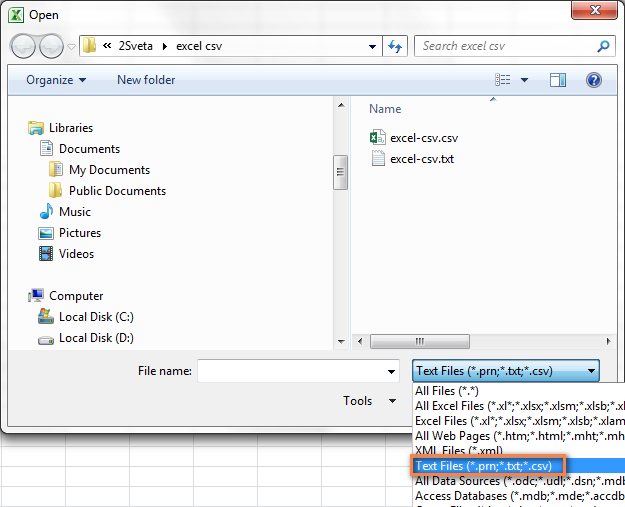
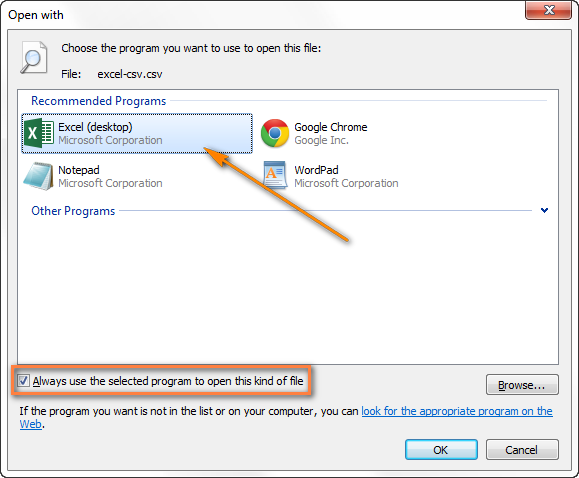

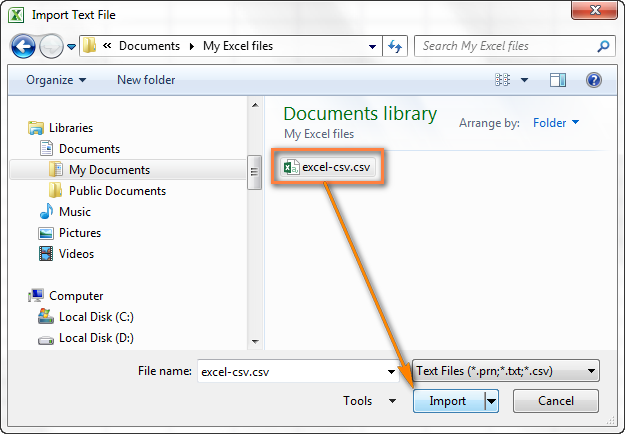
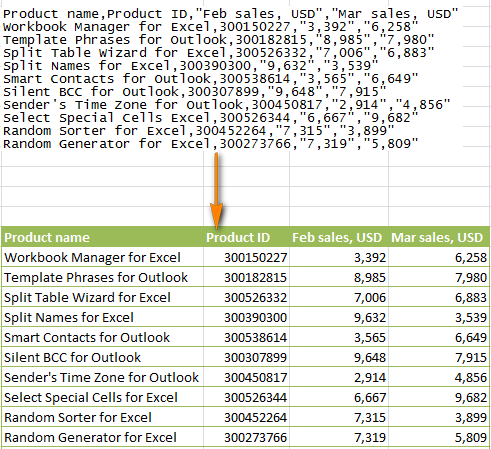
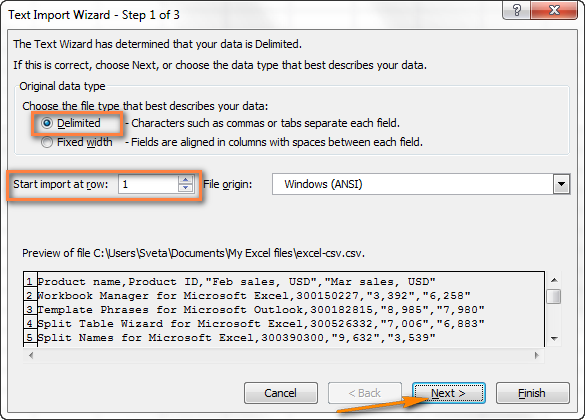
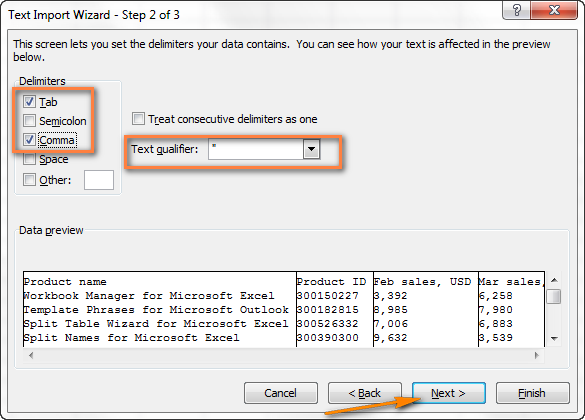
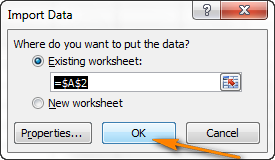
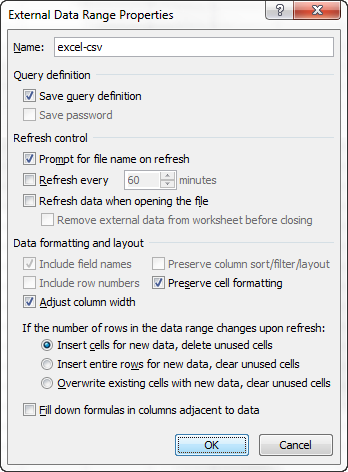
 Когда запустится Мастер распределения текста по столбцам, на первом шаге выберите формат данных Delimited (С разделителями) и нажмите Next (Далее). На втором шаге выберите нужный разделитель и нажмите Finish (Готово).
Когда запустится Мастер распределения текста по столбцам, на первом шаге выберите формат данных Delimited (С разделителями) и нажмите Next (Далее). На втором шаге выберите нужный разделитель и нажмите Finish (Готово).
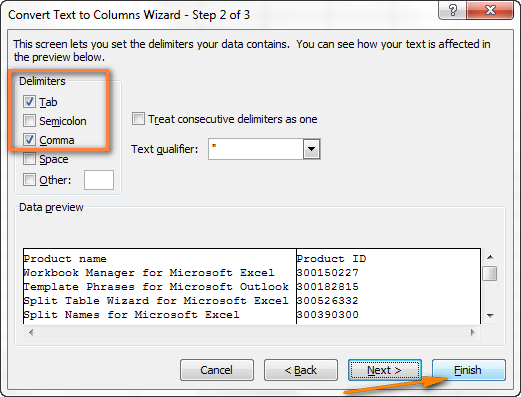
 Дважды нажмите ОК, чтобы закрыть диалоговые окна – всё готово! С этого момента Microsoft Excel будет открывать и отображать все файлы CSV (с разделителем запятой) корректно.
Дважды нажмите ОК, чтобы закрыть диалоговые окна – всё готово! С этого момента Microsoft Excel будет открывать и отображать все файлы CSV (с разделителем запятой) корректно.